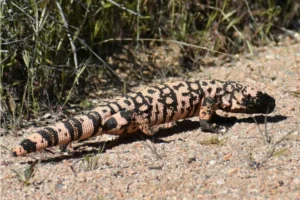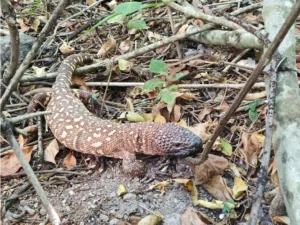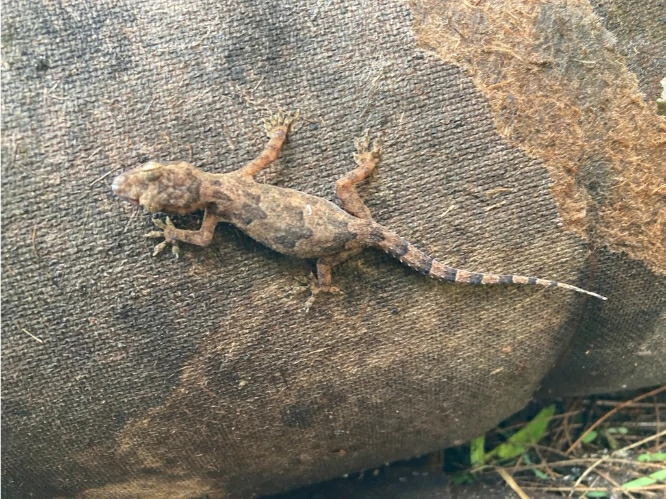If you’ve ever watched your dog run across the yard chasing something, you know how curious they can be. One second they’re sniffing the grass, and the next they’re proudly trotting around with a lizard in their mouth.
It happens all the time, especially in warm areas where lizards are common. But what happens if your dog actually catches or eats one? Are lizards poisonous to dogs?
No, most lizards are not poisonous to dogs, and a quick lizard chase usually isn’t anything to worry about. The vast majority of lizards you’ll see around your home or yard are harmless. They don’t have venom, they don’t carry toxins, and even if your dog eats one, it rarely causes serious trouble.
Still, there are a few exceptions and things to watch out for. Not because lizards are deadly, but because your dog’s curiosity can sometimes get the best of them.
Most Lizards Dogs Find Are Totally Harmless
If you live somewhere with geckos, skinks, or anoles, the good news is they’re not dangerous to your dog.
These lizards don’t have venom or poisonous skin. If your dog grabs one, it’s not likely to cause serious harm.
Most of the time, the only “danger” is a little stomach upset from eating something new. Some dogs might vomit or have soft stools afterward, but they usually bounce back quickly.
Common non-poisonous lizards include:
-
House geckos
-
Green anoles
-
Fence lizards
-
Skinks
-
Blue-tailed lizards
These are the ones you see running along walls, patios, or under furniture, and they don’t pose any real risk to your pets.
A Few Lizards Can Be Dangerous, But Your Dog Probably Won’t Meet Them
While most lizards are harmless, a few can cause real trouble if a dog bites or eats them.
The main ones are:
-
Gila monsters ( Found in southwestern U.S.)

-
Mexican beaded lizards (Found Mexico and parts of Central America)

These two are the only venomous lizards in the world. They have venom in their lower jaws and can give a painful bite.
The good news? They’re not common (they only live in desert areas in parts of the southwestern United States and Mexico), and move slowly. They don’t go looking for dogs.
Bites usually only happen if a dog tries to grab one.
If a dog gets bitten, it might:
-
Show pain and swelling around the bite
-
Drool or foam at the mouth
-
Get weak or start trembling
-
Vomit
A Gila monster bite is serious and needs a vet right away. But unless you live in a desert area where these lizards live, your dog is very unlikely to ever meet one.
Even “Harmless” Lizards Can Cause Trouble For Dogs
Just because a lizard isn’t poisonous doesn’t mean it’s completely safe. Sometimes the problem is what the lizard is carrying.
Here are a few things to watch for:
1. Salmonella bacteria
Many reptiles naturally carry Salmonella in their intestines. It doesn’t make them sick, but if your dog eats or licks one, that bacteria can get into your dog.
Signs your dog might get sick:
-
Vomiting
-
Diarrhea (sometimes with mucus or blood)
-
Lethargy
-
Loss of appetite

Most dogs recover on their own, but puppies or dogs with weak immune systems might need antibiotics or vet care.
2. Parasites
Wild lizards can carry worms or other tiny parasites. If your dog eats one, they can get stomach problems.
Signs include:
-
Weight loss
-
Loose stools
-
Bloating
-
Low energy
Your vet can check for these with a stool sample and give medicine if needed.
3. Chemicals or toxins
Sometimes the problem isn’t the lizard, it’s where it’s been. Lizards that live near pesticides, fertilizers, or rat poison can carry traces of those chemicals.
If your dog eats one of those lizards, it could cause vomiting, drooling, or more serious illness.
What Happens If Your Dog Eats a Lizard?
Most of the time, nothing serious happens. Dogs have tough stomachs and usually digest small critters without problems.
But sometimes your dog might:
-
Throw up once or twice a few hours later
-
Have mild diarrhea for a short time
-
Act a little tired for a day
That’s just their body dealing with something new, like you might feel off after eating a questionable street taco.
If your dog keeps vomiting, has bloody stool, or looks weak, that’s when you call the vet. Sometimes lizards carry bacteria or parasites that can make pets sick.
What If Your Dog Only Licked a Lizard?
That’s even less of a problem. A quick lick or sniff won’t hurt your dog. There’s no poison on a lizard’s skin.

Your dog might wrinkle their nose. Some lizards have a faint earthy or musky smell that dogs notice but humans usually don’t.
You can just wipe your dog’s mouth or give them a drink. No big deal.
“Lizards” That Can Cause Trouble
Newts and salamanders aren’t technically lizards (they’re amphibians, like frogs) but they look similar, and are often mistaken for lizards. I’m including them here just in case.
Some newts, like the rough-skinned newt in the Pacific Northwest or the red eft stage of the eastern newt, have a strong toxin called tetrodotoxin (the same toxin found in pufferfish).

Dogs that eat or mouth one can get very sick. Symptoms may include drooling, vomiting, shaking muscles, or even paralysis in bad cases.
Most dogs never see newts, especially in dry or city areas. They mostly live near ponds, streams, or damp forests.
What About Big Lizards Like Monitors or Iguanas?
If you live where big lizards live, like monitor lizards or iguanas, that’s a little different.
They aren’t poisonous, but they can defend themselves if your dog gets too close. A large monitor lizard can bite hard or whip with its tail, which could hurt a curious dog.
Their mouths also carry bacteria that might cause infection.
Iguanas mostly eat plants, so they aren’t looking to attack dogs, but a tail whip or defensive bite can still hurt.
So while they aren’t poisonous, they aren’t exactly playmates either.
How to Tell If a Lizard Made Your Dog Sick
If your dog eats a lizard, don’t panic. Just watch them over the next 24 hours.
Signs your dog might have eaten something that didn’t agree with them:
-
Vomiting or dry heaving repeatedly
-
Diarrhea lasting more than a day
-
Drooling more than usual
-
Acting tired, restless, or refusing food
-
Shaking or whining
Most of the time, these symptoms are temporary. If they get worse or don’t go away, call your vet. They can give fluids, medicine for nausea, or antibiotics if an infection starts.
Keeping Your Dog Safe From Lizards
You don’t need to freak out every time your dog chases a tail, but you can reduce problems.
-
Watch your dog when they’re outside, especially if lizards are around.
-
Keep bugs under control. Fewer bugs mean fewer lizards and less temptation.
-
Close off doors, windows, and vents so lizards can’t sneak in.
-
Teach a “leave it” command. Training your dog to drop or ignore things can save a lot of trouble.
-
Keep your yard tidy. Rocks, wood, or leaves are great hiding spots for lizards. Cleaning up keeps them away.
What To Do If Your Dog Eats or Bites a Lizard
If it happens, stay calm. Most of the time, it’s not an emergency.
-
Remove your dog from the area. You don’t want them going back for seconds.
-
Check their mouth for cuts, swelling, or bits of lizard.
-
Wipe their mouth with a damp cloth to remove bacteria or slime.
-
Watch for vomiting, diarrhea, drooling, or tiredness over 24–48 hours.
-
Call your vet if something seems off. Even if they seem fine, it’s worth a quick check-in.
When to Go to the Vet Right Away
Call your vet if:
-
They can’t stop vomiting or have bloody diarrhea
-
They drool a lot or foam at the mouth
-
They have tremors, seizures, or collapse
-
Swelling around the mouth or face
-
They ate a large lizard or one you don’t recognize
If you’re unsure what kind it was, take a photo or describe it to the vet. That helps them figure out what to do.
Lizards Aren’t Out to Get Dogs
Lizards don’t attack dogs. They only bite if they feel threatened or grabbed. Dogs usually do the chasing, and the lizard is just trying to get away.
Even venomous lizards like Gila monsters prefer to be left alone. They only bite in self-defense. As long as your dog doesn’t harass or eat them, there’s really no danger.
Conclusion
So, are lizards poisonous to dogs? No. Almost all lizards are safe.
Most of the time, your dog might chase, lick, or even eat a lizard without any serious effect.
The only things to watch for are mild stomach upset or, rarely, bacteria like Salmonella.
The only venomous lizards in the world (Gila monsters and Mexican beaded lizards) live in deserts and don’t interact with pets much.
If your dog has been sniffing a garden lizard or chewing on a gecko, don’t panic.
Keep an eye on them, give them water, and maybe teach them that not every moving thing is a snack.
Lizards and dogs can share the same yard; one keeps the bugs down, the other keeps life interesting.
Hi, my name is Ezra Mushala, i have been interested animals all my life. I am the main author and editor here at snakeinformer.com.

